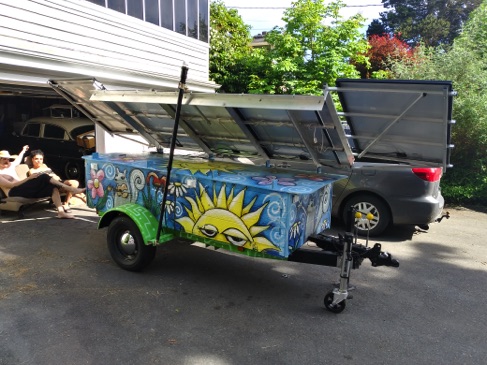The trailer has 6 recycled Sanyo 190 watt photovoltaic panels installed on the roof.
That's 1140 watts of solar electricity, with the capacity to plug in more panels (and a 5-bicycle, 200 watt generator!) outboard if so desired.
The Battery pack consists of 42 recycled Nissan Leaf Li-Ion batteries.
That's 21 kWh of storage.
Or about a day of electricity consumption for a typical small US house.
That's more than enough to run an off-grid wedding with a PA system, a DJ, lights, or a band.
The inverter can supply up 60 amps continuous AC power, with aditional peak power available for turning on appliances, for example.
The trailer's panels, then, could roughly supply the energy needs of a typical US household... on a sunny summer day, with 10 hours of good sunlight.
The batteries help meet peak demand during events, and completely smooth out cloudy moments.
If the sky were to go cloudy, or if an event lasted after the sun set, the trailer would be able to continue to provide uninterrupted power for hours (depending of course, on demand)
It would take about 20 sunny hours for the trailer's solar array to fully charge the battery pack, without any additional outflow. Obviously, the trailer arrives at events with a full charge. :).
The trailer is about 8 feet wide, and 16 feet end-to-end, with panels unfolded and deployed. The entire panel array tilts to face perpendicular to the sun, up to a maximum of 9 feet high.
The trailer needs a clear footprint of about 18 feet by 10 feet. and additional 20 feet of length if the tow vehicle remains attached.
It needs an approximately level (but not perfect surface).
The solar panels will perform at best efficiency if they are positioned perpendicular to the sun throughout the day.
The panel array tilting system can be operated by hand, and the entire trailer and its solar array can be turned by hand to face the sun, on a paved and level surface.
Optimum position can be measured by an on-board sighting system, or by monitoring energy output.
The trailer would ideally be positioned:
Morning: trailer axis north-south, with panels facing EAST, tilted high because sun is low.
Noon: trailer axis east-west, with panels facing SOUTH, tilted low bewcause sun is high.
Late Afternoon: trailer axis north-south, with panels facing WEST, tilted high because sun is low.
Repositioning the trailer multiple times is ideal over the course of a day, and the panel output would be optimized by a 15 degree turn every hour.
But that's not strictly necessary, depending on site logistics, and depending on how much energy your project or event demands. We can help you calculate that...
We're not proud of it :) but we also bring a quiet portable gas powered generator along for emergency backup, so we never have to leave an event unpowered, even in the event of a solar power malfunction.

